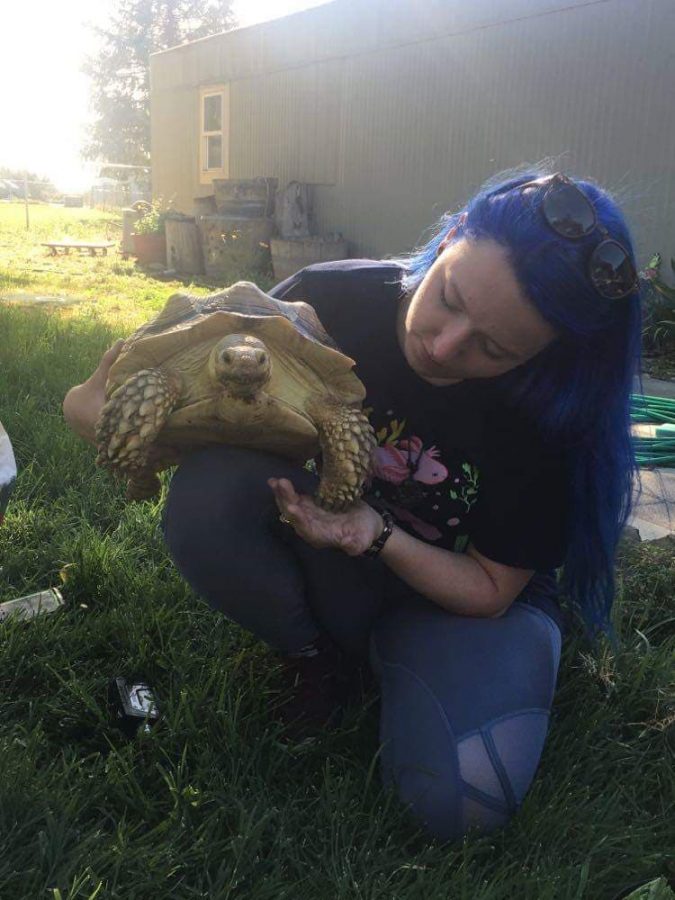Tortoise saved after being run over, left for dead
Terri the tortoise stayed at WSU veterinary hospital for nearly three months; her shell was damaged, spinal cord exposed
Kyley Ackerson, aquatic pet specialist for Petco, holds Terri the tortoise. Terri’s shell was injured after getting run over, and she is still recovering.
July 14, 2020
When an engaged couple saw a tortoise with part of her shell missing, they may not have known much about tortoises, but they knew they had to help her.
Kyley Ackerson, aquatic pet specialist for Petco, said she and her fiance drove over two hours to the WSU Veterinary Teaching Hospital, the closest place that could help the tortoise on such short notice.
“It was just sympathy and empathy for her, and we just wanted to help her out,” said David Cotton, Ackerson’s fiance.
Ackerson said she and Cotton later named the tortoise Terri.
Cotton said Terri was originally owned by their neighbor. When the neighbor’s young daughters were playing with the tortoise in the backyard, the tortoise had gotten lost because the gate was open.
The neighbor had accidentally run her over, ripping off the top of her shell, and left her in the driveway for hours, thinking she was dead, Cotton said.
When a maintenance man came later, he realized Terri was alive and brought her to the couple, Ackerson said. He thought they might know what to do because they own turtles.
Terri had a large wound because she was missing part of her shell. A small section of her spinal cord was exposed, said Dr. Marcie Logsdon, Terri’s veterinarian and clinical instructor in the WSU Exotics and Wildlife Department.
“Fortunately, the spinal cord itself was still in really good shape, and so that was a little bit of a miracle right there given how extensive the rest of the trauma was,” Logsdon said.
The protective membrane underneath the shell that protects the tortoise’s organs was still intact, Logsdon said. However, Terri’s hind legs were weak and slow to move because of the trauma to her spinal cord.
Logsdon said the first priority was to get the spinal cord covered and protected. The doctors also had to make sure there were no internal injuries or bleeding. They cleaned out large debris, like gravel, covered the spinal cord with a protective covering, and put a bandage on the exposed area.
They gave Terri fluids to protect her heart and cardiovascular system as well as antibiotics to prevent infections and pain medication, Logsdon said.

Cotton said he and Ackerson did not really consider how much the injuries might cost. They are financially stable and assumed they would have to spend at least $1,500.
“It was either euthanize her or let her be treated, and we were like if she can be saved, then obviously we want to save her,” Ackerson said.
The engaged couple raised $947 through a Facebook fundraiser, around $300 in cash donations and spent around $2,000 out of pocket, Cotton said.
Throughout the months that Terri spent in the hospital, Logsdon sent the new owners pictures and videos of the tortoise and her progress because they were not able to visit her in person, Ackerson said.
After almost three months in the VTH, the doctors sent Terri home with the couple. Now, Terri’s wound needs bandage changes about once a week, which her new owners can handle, Logsdon said. Terri’s legs have improved too, and she can use her hind legs very well.
Logsdon said she was grateful that Ackerson and Cotton cared enough to look after Terri. The two stuck with the tortoise through thick and thin, she said.
Ackerson said she and Cotton are keeping Terri in a 6 by 8 foot pen, and when they let her out, she “mows our grass.”








